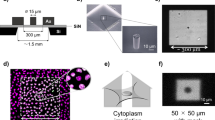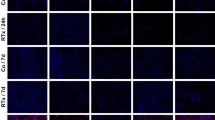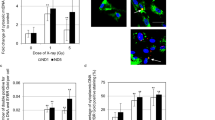Abstract
Radiosensitivity of various normal tissues is largely dependent on radiation-triggered signal transduction pathways. Radiation simultaneously initiates distinct signaling from both DNA damage and cell membrane. Specifically, DNA strand breaks initiate cell-cycle delay, strand-break repair or programmed cell death, whereas membrane-derived signaling through phosphatidylinositol 3-kinase/Akt and mitogen-activated protein kinase/extracellular signal-regulated kinase (ERK) enhances cell viability. Here, activation of cytosolic phospholipase A2 (cPLA2) and production of the lipid second-messenger lysophosphatidylcholine were identified as initial events (within 2 min) required for radiation-induced activation of Akt and ERK1/2 in vascular endothelial cells. Inhibition of cPLA2 significantly enhanced radiation-induced cytotoxicity due to an increased number of multinucleated giant cells and cell cycle-independent accumulation of cyclin B1 within 24–48 h of irradiation. Delayed programmed cell death was detected at 72–96 h after treatment. Endothelial functions were also affected by inhibition of cPLA2 during irradiation resulting in attenuated cell migration and tubule formation. The role of cPLA2 in the regulation of radiation-induced activation of Akt and ERK1/2 and cell viability was confirmed using human umbilical vein endothelial cells transfected with shRNA for cPLA2α and cultured embryonic fibroblasts from cPLA2α−/− mice. In summary, an immediate radiation-induced cPLA2-dependent signaling was identified that regulates cell viability and, therefore, represents one of the key regulators of radioresistance of vascular endothelial cells.
Similar content being viewed by others
Log in or create a free account to read this content
Gain free access to this article, as well as selected content from this journal and more on nature.com
or
Abbreviations
- PLA2:
-
phospholipase A2
- PI3K:
-
phosphatidylinositol 3-kinase
- MAPK:
-
mitogen-activated protein kinase
- ERK:
-
extracellular signal-regulated kinase
- AA:
-
arachidonic acid
- LPC:
-
lysophosphatidylcholine
- HUVECs:
-
human umbilical vein endothelial cells
- MEFs:
-
mouse embryonic fibroblasts
- PBS:
-
phosphate-buffered saline
- TLC:
-
thin-layer chromatography
- PI:
-
propidium iodide
- DAPI:
-
4′,6-diamidino-2-phenylindole
References
Kolesnick R, Fuks Z . Radiation and ceramide-induced apoptosis. Oncogene 2003; 22: 5897–5906.
Haimovitz-Friedman A, Kan CC, Ehleiter D, Persaud RS, McLoughlin M, Fuks Z et al. Ionizing radiation acts on cellular membranes to generate ceramide and initiate apoptosis. J Exp Med 1994; 180: 525–535.
Geng L, Tan J, Himmelfarb E, Schueneman A, Niermann K, Brousal J et al. A specific antagonist of the p110delta catalytic component of phosphatidylinositol 3′-kinase, IC486068, enhances radiation-induced tumor vascular destruction. Cancer Res 2004; 64: 4893–4899.
Edwards E, Geng L, Tan J, Onishko H, Donnelly E, Hallahan DE. Phosphatidylinositol 3-kinase/Akt signaling in the response of vascular endothelium to ionizing radiation. Cancer Res 2002; 62: 4671–4677.
Tan J, Hallahan DE . Growth factor-independent activation of protein kinase B contributes to the inherent resistance of vascular endothelium to radiation-induced apoptotic response. Cancer Res 2003; 63: 7663–7667.
Tan J, Geng L, Yazlovitskaya EM, Hallahan DE . Protein kinase B/Akt-dependent phosphorylation of glycogen synthase kinase-3beta in irradiated vascular endothelium. Cancer Res 2006; 66: 2320–2327.
Valerie K, Yacoub A, Hagan MP, Curiel DT, Fisher PB, Grant S et al. Radiation-induced cell signaling: inside-out and outside-in. Mol Cancer Ther 2007; 6: 789–801.
Mikkelsen RB, Wardman P . Biological chemistry of reactive oxygen and nitrogen and radiation-induced signal transduction mechanisms. Oncogene 2003; 22: 5734–5754.
Maclachlan T, Narayanan B, Gerlach VL, Smithson G, Gerwien RW, Folkerts O et al. Human fibroblast growth factor 20 (FGF-20; CG53135-05): a novel cytoprotectant with radioprotective potential. Int J Radiat Biol 2005; 81: 567–579.
Cabral GA . Lipids as bioeffectors in the immune system. Life Sci 2005; 77: 1699–1710.
Farooqui AA, Horrocks LA . Phospholipase A2-generated lipid mediators in the brain: the good, the bad, and the ugly. Neuroscientist 2006; 12: 245–260.
Chakraborti S . Phospholipase A(2) isoforms: a perspective. Cell Signal 2003; 15: 637–665.
Bonventre JV . The 85-kD cytosolic phospholipase A2 knockout mouse: a new tool for physiology and cell biology. J Am Soc Nephrol 1999; 10: 404–412.
Prokazova NV, Zvezdina ND, Korotaeva AA . Effect of lysophosphatidylcholine on transmembrane signal transduction. Biochemistry (Mosc) 1998; 63: 31–37.
Fujita Y, Yoshizumi M, Izawa Y, Ali N, Ohnishi H, Kanematsu Y et al. Transactivation of fetal liver kinase-1/kinase-insert domain-containing receptor by lysophosphatidylcholine induces vascular endothelial cell proliferation. Endocrinology 2006; 147: 1377–1385.
Murugesan G, Sandhya Rani MR, Gerber CE, Mukhopadhyay C, Ransohoff RM, Chisolm GM et al. Lysophosphatidylcholine regulates human microvascular endothelial cell expression of chemokines. J Mol Cell Cardiol 2003; 35: 1375–1384.
Sugiyama S, Kugiyama K, Ogata N, Doi H, Ota Y, Ohgushi M et al. Biphasic regulation of transcription factor nuclear factor-kappaB activity in human endothelial cells by lysophosphatidylcholine through protein kinase C-mediated pathway. Arterioscler Thromb Vasc Biol 1998; 18: 568–576.
Dent P, Yacoub A, Fisher PB, Hagan MP, Grant S . MAPK pathways in radiation responses. Oncogene 2003; 22: 5885–5896.
Dent P, Yacoub A, Contessa J, Caron R, Amorino G, Valerie K et al. Stress and radiation-induced activation of multiple intracellular signaling pathways. Radiat Res 2003; 159: 283–300.
Hwang A, Muschel RJ . Radiation and the G2 phase of the cell cycle. Radiat Res 1998; 150: S52–S59.
Kramer A, Lukas J, Bartek J . Checking out the centrosome. Cell Cycle 2004; 3: 1390–1393.
Castedo M, Perfettini JL, Roumier T, Kroemer G . Cyclin-dependent kinase-1: linking apoptosis to cell cycle and mitotic catastrophe. Cell Death Differ 2002; 9: 1287–1293.
Castedo M, Perfettini JL, Roumier T, Andreau K, Medema R, Kroemer G . Cell death by mitotic catastrophe: a molecular definition. Oncogene 2004; 23: 2825–2837.
Ianzini F, Bertoldo A, Kosmacek EA, Phillips SL, Mackey MA . Lack of p53 function promotes radiation-induced mitotic catastrophe in mouse embryonic fibroblast cells. Cancer Cell Int 2006; 6: 11.
Valko M, Leibfritz D, Moncol J, Cronin MT, Mazur M, Telser J . Free radicals and antioxidants in normal physiological functions and human disease. Int J Biochem Cell Biol 2007; 39: 44–84.
Rodel F, Keilholz L, Herrmann M, Sauer R, Hildebrandt G . Radiobiological mechanisms in inflammatory diseases of low-dose radiation therapy. Int J Radiat Biol 2007; 83: 357–366.
Pelevina II, Gotlib V, Konradov AA . 20 years after Chernobyl accident – is it a lot or not for the estimation its characteristics? Radiats Biol Radioecol 2006; 46: 240–247.
Geng L, Donnelly E, McMahon G, Lin PC, Sierra-Rivera E, Oshinka H et al. Inhibition of vascular endothelial growth factor receptor signaling leads to reversal of tumor resistance to radiotherapy. Cancer Res 2001; 61: 2413–2419.
Kufe D, Weichselbaum R . Radiation therapy: activation for gene transcription and the development of genetic radiotherapy-therapeutic strategies in oncology. Cancer Biol Ther 2003; 2: 326–329.
Truman JP, Gueven N, Lavin M, Leibel S, Kolesnick R, Fuks Z et al. Down-regulation of ATM protein sensitizes human prostate cancer cells to radiation-induced apoptosis. J Biol Chem 2005; 280: 23262–23272.
Hirabayashi T, Murayama T, Shimizu T . Regulatory mechanism and physiological role of cytosolic phospholipase A2. Biol Pharm Bull 2004; 27: 1168–1173.
Tsutsumi H, Kumagai T, Naitoo S, Ebina K, Yokota K . Synthetic peptide (P-21) derived from Asp-hemolysin inhibits the induction of apoptosis on HUVECs by lysophosphatidylcholine. Biol Pharm Bull 2006; 29: 907–910.
Cuneo KC, Geng L, Tan J, Brousal J, Shinohara ET, Osusky K et al. SRC family kinase inhibitor SU6656 enhances antiangiogenic effect of irradiation. Int J Radiat Oncol Biol Phys 2006; 64: 1197–1203.
Abdollahi A, Lipson KE, Han X, Krempien R, Trinh T, Weber KJ et al. SU5416 and SU6668 attenuate the angiogenic effects of radiation-induced tumor cell growth factor production and amplify the direct anti-endothelial action of radiation in vitro. Cancer Res 2003; 63: 3755–3763.
Zaher TE, Miller EJ, Morrow DM, Javdan M, Mantell LL . Hyperoxia-induced signal transduction pathways in pulmonary epithelial cells. Free Radic Biol Med 2007; 42: 897–908.
Ricci MS, Zong WX . Chemotherapeutic approaches for targeting cell death pathways. Oncologist 2006; 11: 342–357.
Upton AC . Carcinogenic effects of low-level ionizing radiation. J Natl Cancer Inst 1990; 82: 448–449.
Pierce DA, Shimizu Y, Preston DL, Vaeth M, Mabuchi K . Studies of the mortality of atomic bomb survivors. Report 12, Part I. Cancer: 1950–1990. Radiat Res 1996; 146: 1–27.
Herbert SP, Ponnambalam S, Walker JH . Cytosolic phospholipase A2-alpha mediates endothelial cell proliferation and is inactivated by association with the Golgi apparatus. Mol Biol Cell 2005; 16: 3800–3809.
Bligh EG, Dyer WJ . A rapid method of total lipid extraction and purification. Can J Biochem Physiol 1959; 37: 911–917.
Acknowledgements
We appreciate gift of mouse embryonic fibroblasts MEFcPLA2α−/− and MEFcPLA2α+/+ from Dr. JV Bonventre (Harvard Medical School, Boston, MA, USA). This work was supported in part by NIH grants R01-CA112385, R01-CA88076, R01-CA89674, R01-CA89888, and P50-CA90949, Elsa U. Pardee Foundation, Ingram Charitable Fund and Vanderbilt-Ingram Cancer Center, CCSG P30-CA68485.
Author information
Authors and Affiliations
Corresponding author
Additional information
Edited by SH Kaufmann Ciao
Rights and permissions
About this article
Cite this article
Yazlovitskaya, E., Linkous, A., Thotala, D. et al. Cytosolic phospholipase A2 regulates viability of irradiated vascular endothelium. Cell Death Differ 15, 1641–1653 (2008). https://doi.org/10.1038/cdd.2008.93
Received:
Revised:
Accepted:
Published:
Issue date:
DOI: https://doi.org/10.1038/cdd.2008.93
Keywords
This article is cited by
-
Targeting the enzymes involved in arachidonic acid metabolism to improve radiotherapy
Cancer and Metastasis Reviews (2018)
-
Anti-vascular effects of the cytosolic phospholipase A2 inhibitor AVX235 in a patient-derived basal-like breast cancer model
BMC Cancer (2016)
-
Phospholipase signalling networks in cancer
Nature Reviews Cancer (2012)



